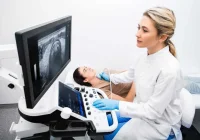Ovarian cancer remains a major global health concern, ranking as the third most common gynaecological malignancy. Outcomes vary significantly depending on the stage of diagnosis, with survival rates far lower for advanced disease. Accurate classification of ovarian lesions is therefore essential, guiding timely and appropriate treatment. While ultrasound is the first-line imaging method, its limitations mean that around one in five adnexal masses require further evaluation. Magnetic resonance imaging offers superior tissue contrast for complex lesions, yet manual interpretation is demanding and prone to variability. Recent advances in artificial intelligence have opened new possibilities for automated lesion segmentation and classification, potentially supporting radiologists in high-stakes decision-making.
Integrating Foundation Models with MRI
Deep learning applications have demonstrated promising results in classifying ovarian tumours, but many approaches rely on manual lesion segmentation, which is labour-intensive and introduces bias. Automatic segmentation remains challenging due to noise in abdominal MRI and the proximity of surrounding organs. Foundation models, trained on vast datasets, have shown strong potential for segmentation tasks across modalities. The Segment Anything Model was introduced as a universal segmentation framework requiring minimal user input. Its application to ovarian lesion classification had not been widely explored, prompting an investigation into whether integrating it with a deep learning classifier could yield efficient, generalisable performance.
This approach was tested across datasets from three academic centres in the United States and Taiwan, encompassing more than 500 ovarian lesions with histopathological confirmation. By combining the automated segmentation with multiparametric imaging and clinical features, the aim was to build an end-to-end pipeline capable of reducing manual workload while maintaining diagnostic accuracy.
Efficiency and Accuracy of Automated Segmentation
In direct comparisons, the Segment Anything Model achieved strong segmentation accuracy, with Dice coefficients ranging from 0.86 to 0.88 across external datasets. It also demonstrated reproducibility, reaching coefficients up to 0.93 on repeated segmentations. Importantly, efficiency was markedly improved. Manual segmentation took between 7 and 11 minutes per lesion, whereas automated methods reduced this to between 3 and 6 minutes, saving an average of four minutes for each case.
The benchmark nnU-Net segmentation model was also tested but performed significantly worse, with Dice coefficients of only 0.41 to 0.43. These results highlight the benefits of applying general-purpose foundation models to medical imaging. By maintaining accuracy while reducing time requirements, the Segment Anything Model addresses one of the primary barriers to clinical adoption of deep learning in this context.
Classification Performance Compared with Radiologists
The deep learning classification model used both imaging and clinical information, including menopausal status and cancer antigen 125 levels. On the internal test set, the model achieved an area under the curve (AUC) of 0.85 with 83% accuracy. External validation demonstrated consistent results, with AUCs of 0.79 to 0.83 and accuracies of 79% to 83% across datasets. Notably, classification performance remained robust whether manual or automated segmentation was used.
Must Read: Updated Imaging Guidelines for Ovarian Cancer
Radiologists interpreting the same cases with Ovarian-Adnexal Reporting and Data System MRI scoring achieved AUCs of 0.84, while subjective expert assessments reached 0.86 to 0.93. No statistically significant differences were observed between radiologists’ interpretations and the model’s predictions. Interrater agreement among radiologists varied, but the artificial intelligence pipeline delivered consistent performance across sites. This suggests potential for the model to function as a second reader, providing reliable outputs that radiologists can use to cross-check their evaluations.
Such a system could prove particularly valuable in high-volume environments, where radiologists face time pressure and diagnostic accuracy is critical. By handling routine segmentation and offering a classification probability, the pipeline may help direct attention to more complex cases.
Accurate diagnosis of ovarian lesions is vital for ensuring optimal treatment pathways and improving patient outcomes. Manual methods remain resource intensive, and although radiologists achieve high levels of accuracy, the workload associated with segmentation and classification is substantial. Integrating a foundation segmentation model with a multiparametric deep learning classifier offers an efficient alternative. The approach demonstrated segmentation accuracy on par with expert readers, reduced processing time and maintained classification performance across diverse datasets.
Combining artificial intelligence with radiologist expertise could streamline imaging workflows, support consistency across institutions and ultimately enhance patient care. Advances in automated imaging analysis represent a step toward more efficient, equitable diagnostic services.
Source: Radiology
Image Credit: iStock







